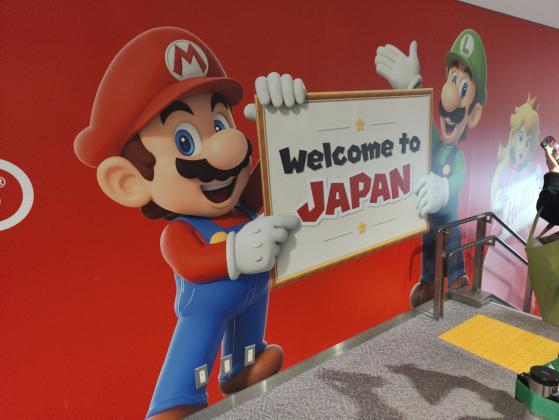OKIE REALIST
From the moment I stepped off the plane, I could tell that I was in Japan. No, this was not from being surrounded by Japanese people; my clue came from walking through the international terminal at Tokyo’s Narita International Airport after disembarking and being greeted by Mario, Luigi, Princess Peach, Bowser, Donkey Kong, Yoshi, and all the characters from Nintendo’s “Mario Universe”, all with signs shouting “Welcome to Japan!” This display went on for at least several hundred meters and three down escalators.
This strangely-appropriate tableau presented the first of many situations in which Japan does what it does best: present itself to you as what you expect to see, on its best terms.
My flight to Tokyo was delayed nearly three hours, so rather than arriving in the middle of the afternoon and seeing the city in daylight, I took an Uber to my hotel in the dark. This turned out to be a much better option, however. Tokyo is an absolutely beautiful city to see at night, amazingly lit up, especially along the bay. As I crossed Tokyo’s Rainbow Bridge, the city presented one of the most striking urban scenes from my travels, easily rivaling any of the amazing cityscapes I took in on my travels.
Japan shows well in other ways, however; everything is formal, all the time. No one who works in Tokyo dresses informally. Japanese office workers appear to have their own “uniform” of black or navy dress pants and jackets, white shirts, and dark solidcolor ties for men, and ladies dress similarly with dark skirts and white or light-colored blouses.
Even doormen, guards, and attendants wear a standard uniform that almost makes them appear as though they live in military dress, with pressed and creased trousers, starched shirts, uniform jackets, peaked caps, and even white gloves, which are a ubiquitous symbol in Tokyo. Let me tell you, once you see the white gloves, you can’t un-see them…they are EVERYWHERE on service employees. Even taxi drivers wear them all the time as they drive you through the crowded streets.
Every entrance to every office building I went to has several such sharplydressed guards, with at least one who simply stands right outside the card-reader security gates, loudly and repeatedly saying “ohayou gozaimasu” (“good morning” in Japanese), as the many office workers silently file past them on their way to another workday. I witnessed this multiple times, and it was clear this was not done for my benefit; this was a typical Tokyo morning!
Tokyo businessmen live in constant formality. Even exchanging business cards requires a very specific ritual that would seem incredibly out-of-place anywhere else. The Japanese are well-known for their bowing in respect, and that is legitimate. Nor are they leaving this tradition behind, as we in the West are leaving behind many of our own social traditions and conventions; it’s real for them, all the time. As I left every engagement with my local team, we stood inside the elevator and bowed low, and those we met with did the same, until the elevator doors had closed.
Technologically, Japan lives in perhaps the most leading edge, again as one would expect. However, there is an area in which Japan far surpasses all other places I visited: toilets. I will say without hesitation that the toilets in Japan are easily the finest in the world; even the incredible modernity of Dubai can’t match Japan for their bathroom fixtures. I was shamed by how far behind we are here in terms of what we provide in our bathrooms.
The toilets in Japan routinely feature heated seats, something we might consider somewhat gross in the US, as a warm toilet seat typically means something different here. However, once you get used to them, you don’t want to be without them. Japanese toilets also have built-in bidet fixtures with both hot and cold water, with multiple pressure levels for stronger or weaker spray streams against your backside. They typically have warm-air blowers to dry you off, and several I saw even had lids that automatically opened and closed.
As an example, my local team took me out for sushi in Tokyo’s historic Tsukiji Outer Market, since my wife and daughter would have skinned me alive if I left Tokyo without sampling authentic Japanese sushi and sashimi. The food was very good, though the restaurant itself was what we would generously refer to in the States as a “hole in the wall”. I took a restroom break halfway through the meal and wound my way through dank back hallways to the men’s room, opened the door….and was immediately greeted by the high-end toilet automatically opening its lid for me. Japan has its standards, you know, even in a sushi dive.
— END OF DISPATCH



